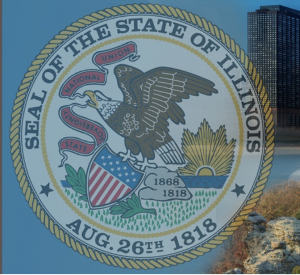Illinois Department of Revenue
Illinois Department of Revenue
Grocery Tax Suspension & State Sales Tax Holiday
Grocery Tax Suspension
Going on from July 1, 2022, through June 30, 2023
Public Act (P.A.) 102-0700 suspends the state 1 percent (1%) low rate of sales and use tax on retail sales of groceries normally taxed at this rate from July 1, 2022, through June 30, 2023.
How does the 1 percent (1%) grocery tax suspension work?
From July 1, 2022, through June 30, 2023, the state of Illinois sales and use tax on groceries normally taxed at the 1 percent (1%) low rate will be 0 percent (0%). Groceries taxed at the low rate include food for human consumption that is to be consumed off the premises where it is sold (other than alcoholic beverages, food consisting of or infused with adult use cannabis, soft drinks, candy, and food that has been prepared for immediate consumption). See 86 Ill. Admin. Code Section 130.310 for more information on grocery items that are taxed at the low rate.
Are there any sales and use tax notification requirements for retailers?
Retailers, to the extent feasible, shall include the following statement on any cash register tape, receipt, invoice, or sales ticket issued to customers: “From July 1, 2022, through June 30, 2023, the State of Illinois sales tax on
groceries is 0%.” If it is not feasible for the retailer to include the statement on any cash register tape, receipt, invoice, or sales ticket issued to customers, then the retailer shall post the statement on a sign that is clearly visible to customers. The sign shall be no smaller than 4 inches by 8 inches.
If an item qualifies as a drug or medicine is the tax suspended?
No. Tax will continue to be imposed on items that meet the definition of a qualifying medicine or drug. See 86 Ill. Admin. Code Section 130.311 for more information.
How do I report these sales?
The Illinois Department of Revenue has created Schedule GT, Sales and Use Tax Holiday and Grocery Tax Suspension Schedule, for retailers to report sales of groceries during the tax suspension period. This schedule should be filed with your Form ST-1, Sales and Use Tax and E911 Surcharge Return (and, when applicable, Form ST-2, Multiple Site Form). Form ST-1 has not changed. Retailers should continue to report their normal taxable sales, including receipts from sales of groceries, on Lines 5a and 5b, Lines 7a and 7b, or Lines 13a and 13b, of Form ST-1 (and, when applicable, Form ST-2) and will then use Lines 6a and 6b, Lines 7a and 7b, or Lines 8a and 8b on Schedule GT to calculate a credit against the tax reported on those lines for the tax they are not collecting on sales of grocery items. When determining the discount allowed for a timely filed return, retailers are authorized to include the amount of tax on receipts that would have been due at the 1 percent (1%) rate.
State Sales Tax Holiday
Going on from August 5, 2022, through August 14, 2022
Public Act (P.A.) 102-0700 creates a state sales tax holiday on qualifying items effective August 5, 2022, through August 14, 2022.
What is the state sales tax holiday?
The state sales tax holiday is a ten-day period during which consumers can purchase certain clothing and school-related items and pay sales tax at a reduced rate. The state’s portion of sales tax due throughout the holiday is reduced by 5 percent (5.00%) from 6.25 percent (6.25%) to 1.25 percent (1.25%). Items include qualifying clothing and footwear with a retail selling price of less than $125 per item and certain school supplies used by students in the course of study. School supplies are not subject to the $125 threshold. For a list of qualifying and non-qualifying items, see Page 3.
What action must the retailer take?
Retailers must adjust their method of collecting sales tax so that beginning on August 5, 2022, and ending at the close of business August 14, 2022, they will collect the reduced tax rate on qualifying items. The sales tax rate that retailers must use during the holiday period is the rate currently in effect on the date of the holiday minus 5.00 percent (5.00%).
How do I handle special sales during the sales tax holiday?
Coupons and discounts To determine whether the eligible clothing item’s retail selling price is below $125, retailers must look at the price after the unreimbursed coupon or store markdown but before a reimbursed coupon.
- Bundled sales Qualifying items bundled with items that do not qualify for the state sales tax holiday rate will be subject to the reduced tax rate only if the value of the qualifying items exceed the value of the non-qualifying items. Bundled sales are limited to $125 for one bundled sale that includes qualifying clothing/shoes.
- Splitting items Articles normally sold as a single unit must continue to be sold as such to determine whether the selling price is within the state sales tax holiday price threshold. For example, a pair of shoes with a selling price of $140 cannot be sold separately so the sales price of each shoe is within the sales tax holiday price threshold.
- Rain checks Qualifying items purchased during the holiday with a rain check issued prior to the state sales tax holiday will qualify for the reduced sales tax rate. Qualifying items purchased after the state sales tax holiday with rain checks issued during the holiday are not eligible for the reduced tax rate.
- Exchanges Retailers do not need to collect any additional tax if a customer purchases a qualifying item during the state sales tax holiday, but after the holiday exchanges it for a different size, color, or other feature at the same or lower price. If a customer purchases a qualifying item during the state sales tax holiday, but after the holiday returns the item and receives credit on the purchase of a different item, they will receive credit for the holiday tax paid. The customer is charged the full sales tax rate on the purchase of a new item. If a customer purchases a qualifying item before the state sales tax holiday period, but returns it during the sales tax holiday period and receives credit on the purchase of a different item that is eligible, the reduced rate of sales tax is due if the replacement item is purchased during the holiday.
- Back orders Regardless of when an item is delivered to a customer, retailers must collect the reduced rate of tax on any qualifying item for which a customer has paid in full during the state sales tax holiday period.
- Returns Retailers may establish their own policies for time periods within which to accept returns of qualifying items. However, for a 60-day period immediately after the Sales Tax Holiday Period, if a customer returns a qualifying item, the retailer must only credit or refund sales tax at the reduced rate unless the customer provides a receipt or invoice showing tax was paid at the usual general merchandise rate, or the retailer has documentation to show tax was paid at the usual general merchandise rate on the item. Retailers must file Form ST-1-X, Amended Sales and Use Tax Return (and, if applicable, Form ST-2-X, Amended Multiple Site Form), and Schedule GT-X, Amended Sales and Use Tax Holiday and Grocery Tax Suspension Schedule, to make a claim for credit for tax paid to IDOR that was subsequently refunded to a customer.
How do I report qualifying sales made during the state sales tax holiday?
Schedule GT, Sales and Use Tax Holiday and Grocery Tax Suspension Schedule, was created for retailers to report sales of qualifying items sold during the sales tax holiday. This schedule should be filed with your From ST-1, Sales and Use Tax and E911 Surcharge Return (and, when applicable, Form ST-2, Multiple Site Form). Form ST-1 has not changed. Retailers should continue to report their normal taxable sales, including sales of qualifying items, on Lines 4a and 4b, Lines 6a and 6b, or Lines 12a and 12b, of Form ST-1 (and, when applicable, Form ST-2) and will then use Lines 2a and 2b, Lines 3a and 3b, or Lines 4a and 4b on Schedule GT to calculate a credit against the tax reported on those lines for the tax they are not collecting during the state sales tax holiday. When determining the discount allowed for a timely filed return, retailers are authorized to include the amount of tax on receipts that would have been due at the rate in effect for their location(s) prior to reducing the state’s portion of sales tax due on sales tax holiday items.
Click here to see the Sales Tax Holiday – Qualifying Items. Find out more here

























